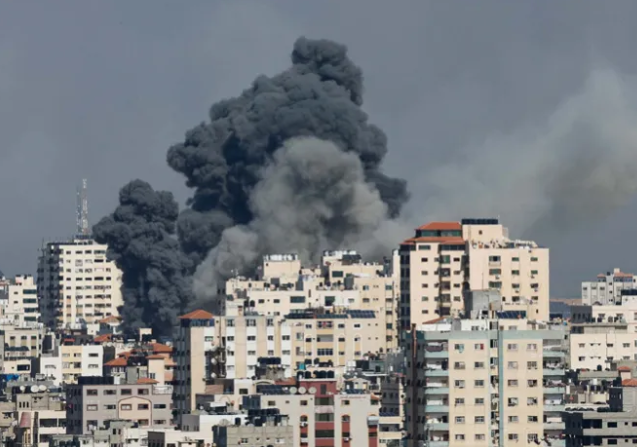Unending War (GS Paper 2, IR)

Introduction
- The ongoing conflict in West Asia, which began in October 2023, has transformed into a complex, multi-faceted war.
- Israel's pre-emptive strike on Lebanon on August 25, 2024, followed by Hezbollah’s retaliatory attacks, underscores the escalating risks and complexities of the war.
- Initially aimed at dismantling Hamas in Gaza, the conflict has evolved into a broader regional issue, with no clear resolution in sight.
- Even Israeli Defense Forces are now questioning the effectiveness and feasibility of their initial objectives.
West-Asia War Zone Dynamics
Israeli Actions and Broader Impact:
- Gaza Conflict: The core of the conflict has been the intense military campaign by Israel in Gaza, launched in response to a major Hamas attack on October 7, 2023. Israel’s strategy involved extensive bombardments with the stated goal of dismantling Hamas. Despite this aggressive approach, the situation has not only persisted but has spread beyond Gaza.
- Spread of Conflict: The war’s impact has reached Israel’s northern border and southern Lebanon. This geographical expansion of the conflict highlights its complexity and the challenges in containing it within a specific area.
Hezbollah’s Role:
- Rocket Attacks: Hezbollah, a Shiite militia group backed by Iran, has been actively involved in the conflict by launching numerous rocket attacks on Israel. These attacks are framed as acts of solidarity with the Palestinians and a direct response to Israeli actions in Gaza.
- Strategic Significance: Hezbollah’s involvement is not merely reactive; it reflects a strategic alignment with Iranian interests and a broader agenda of destabilizing the region. The group's actions have further complicated the conflict dynamics, turning northern Israel into a vulnerable and increasingly depopulated area.
Lebanon’s Casualties and Reactions:
- Airstrikes and Civilian Impact: In retaliation to Hezbollah’s attacks, Israel has conducted airstrikes on Lebanon, targeting both Hezbollah operatives and civilian areas. This has resulted in significant casualties and heightened tensions. The recent escalation was triggered by the Israeli killing of Fuad Shukr, a senior Hezbollah commander, in Beirut on July 31, which was part of a series of high-profile attacks including the killing of Hamas leader Ismail Haniyeh in Tehran.
- Cross-Border Tensions: The violence has exacerbated the humanitarian crisis in Lebanon and has led to increased regional instability. The continuous exchange of attacks between Israel and Hezbollah has had devastating effects on Lebanese civilians and infrastructure.
Escalation and De-Escalation Dynamics:
- Israeli Strategy: On August 25, Israel intensified its strikes on Hezbollah targets, citing a defensive rationale and a need to preempt a large-scale attack by Hezbollah. This escalation was intended to assert control and demonstrate strength.
- Hezbollah’s Retaliation: Despite the Israeli offensive, Hezbollah responded with a substantial barrage of over 300 rockets and drones, resulting in casualties and further inflaming the situation. Hezbollah's actions signal a commitment to continue its resistance and challenge Israeli advances.
- Attempts at De-Escalation: Both sides have made statements reflecting a desire to avoid a broader regional war. Hezbollah leader Hassan Nasrallah claimed that the group had achieved its objectives with the recent attacks, while Israeli Defence Minister Yoav Gallant expressed a preference for de-escalation. However, these statements have not translated into concrete steps towards reducing hostilities, leaving the conflict in a precarious state.
U.S. Mediation and Support:
- Mediation Efforts: The United States has been actively involved in mediating for a ceasefire, reflecting its strategic interest in stabilizing the region. However, its role is dual-faceted, as it also supports Israel with defense supplies and diplomatic backing.
- Impact of U.S. Involvement: While U.S. mediation aims to bring about a ceasefire, its support for Israel complicates the situation, as Hezbollah perceives the U.S. role as partial and biased. This dynamic contributes to the ongoing cycle of violence, as Hezbollah has vowed to continue its attacks as long as the Gaza conflict persists.
Conclusion
- Israel’s strategy of targeting Hezbollah and its commanders aims to reshape the regional balance of power and address the threats posed by the group.
- However, the persistent and increasingly aggressive nature of Hezbollah's attacks suggests that this approach is only partially effective.
- The continued war in Gaza, intended to eliminate Hamas and secure Israel's southern border, has inadvertently intensified insecurity in the north.
- The ongoing conflict with Hezbollah complicates Israel's military objectives and exacerbates regional instability.
- The absence of a clear military solution for Hezbollah and the unresolved conflict in Gaza indicate that the potential for a broader regional war remains high.
- Without a comprehensive and sustained ceasefire, the cycle of escalation and retaliation is likely to continue, perpetuating the instability and suffering in West Asia.


